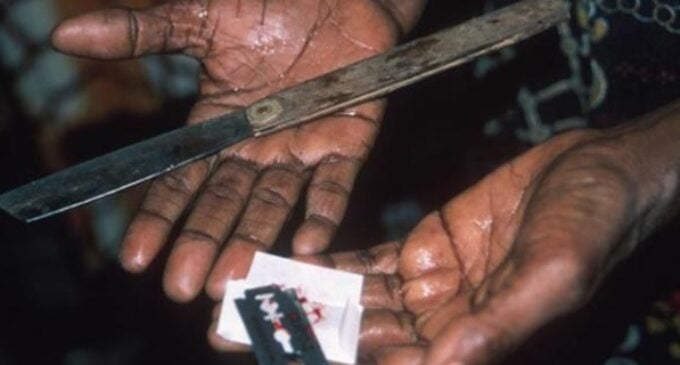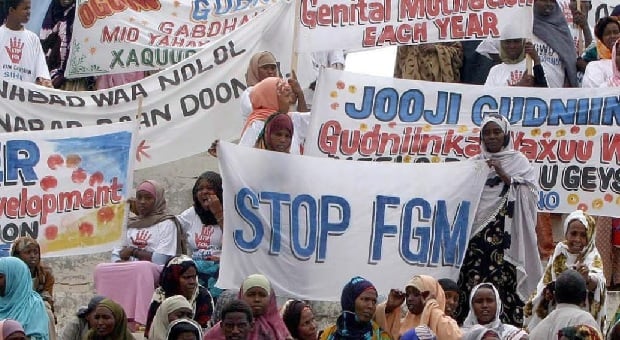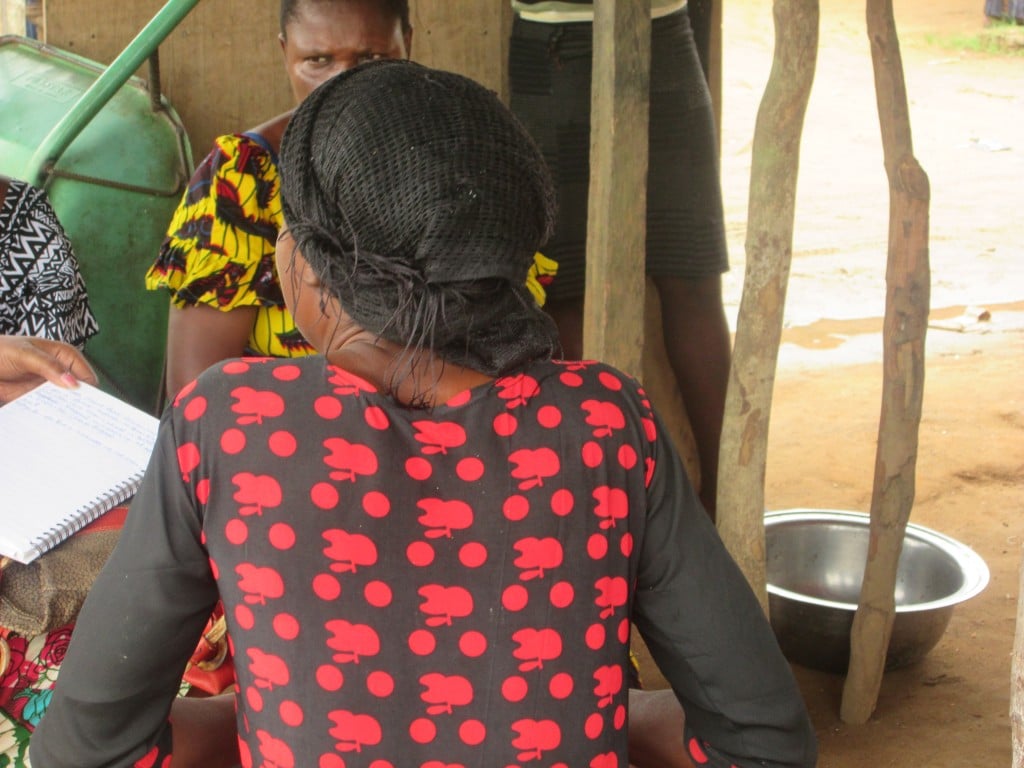Two years after ban, FGM still rampant in Nigeria

“Circumcising her will enable her to control this (sexual) urge so she can stay with her husband without jumping from one man to another,” Muniyat Lamidi rationalises female genital mutilation (FGM).
A petty trader in Oyo, one of the south-west states with a high prevalence of female genital mutilation, Lamidi is adamant and convinced that a woman’s sexuality should be guided, tamed – or it might bring her downfall.
“If it is not done, the girl will be promiscuous and her sexual urges will be too high that she will begin to sleep around,” Lamidi tells Sola Fagurosi of the OneLife Initiative for Human Development, a non-governmental organisation that campaigns against FGM.
Lamidi is not the only one who holds this view, it is the popular narrative of those in defence of mutilation.
Her view finds its roots in the patriarchal structure of the Nigerian society where inequality of the sexes manifests so blatantly that even a gender equality bill promoting equal education opportunities has failed to become a law.
Women’s sexual needs and urges, especially in rural communities, are demonised, policed or at best seen as secondary to a man’s sexual needs.
To prevent promiscuity, Muniyat as well as many other “cutters”, believe the clitoris must be done away with.
And even though it has been internationally recognised as a violation of the human rights of girls and women; and criminalised in Nigeria, FGM still occurs on a scale of massive proportions, especially among the less educated.
According to data from the Nigeria Demographics and Health Survey, 24.8 percent of Nigerian girls and women aged 15 to 49 have been circumcised, with states in the southeast region accounting for 45 percent of FGM cases; and south-western states accounting for up to 55 percent.
Osun state has the highest prevalence of female genital mutilation/cutting in Nigeria with a prevalence of 76.6%, Ebonyi comes next with 74 %, Ekiti has a 72.3% prevalence rate while Imo has a 68 % rate and Oyo, a 65. 6% rate.
The report also shows that cutting occurs mostly at early childhood with 82% of women in Nigeria getting circumcised before the age of five.
One of such cases in the south-west, Ondo precisely, is that of Janet Ajanni, a teaching support staff.
Ajanni narrated her daughter’s ordeal as a victim of FGM to Fagurosi.
She said her daughter would have been long dead had it not been the intervention of medical consultants and surgeons at the University Teaching Hospital in Ibadan.
Ajanni said her mother-in-law caused the circumcision of her daughter, something she tolerated because she had been totally ignorant of FGM and its effect until 2003 when she got married, got pregnant and had the baby.
As many cases of FGM, this case did not end well.
“Six months after I left Ondo for Ibadan, Oyo state with my baby,” Ajanni narrated, adding that it was not until her daughter turned three years that she discovered a growing bump on her genitalia.
“When my girl turned three years, I noticed that where she was cut had swollen. I wondered what it could be whenever I bathed her. By the time she was 8-years-old, it had grown very big.”
Ajanni said when her kid turned eight, she decided to inform her mother-in-law who proffered a re-circumcision as the solution.
This time Ajanni did not heed but by 2010, when her child turned eight the keloid had grown so big that it was alarming.
That was the beginning of the rather tortuous journey to healing, healing that will never be complete as Ajanni’s daughter had got part of her genitalia cut – an act that is irreversible.
“I took her to a clinic in our neighbourhood and was opportune to see a matron. She inserted a syringe into the keloid and said it was mucus that accumulated in it. She recommended some drugs, I paid for her drugs and it was administered on her.”
The drugs made Ajanni’s daughter so drowsy that she slept through school on that day and afterwards, Ajanni said her daughter began to “lose her memory”.
“This made me stop the medications.” she said.
The swelling was still there showing no signs of abating, so Ajanni decided to talk to someone about the situation.
“I explained to one of my customer that works at the University College Hospital, Ibadan post-mortem department,” she said.
“He exclaimed and chastised me for keeping it to myself. I followed his advice and took her to UCH, Ibadan. After the back and forth at the hospital, we eventually saw the doctor who referred us to the laboratory for test. After these series of test, we were asked to come for drugs. (First of all, it was) monthly, then bi-monthly and then weekly.
“When we are almost rounding off her treatment we were asked to see the doctor again, he tested her and told us that the keloid had to be operated.”
Ajanni spent N35,000 naira on the surgical procedure to take out the keloid that was caused by the FGM procedure which cost just N500.
“Without the surgery at the hospital. I would have lost my daughter from complications that followed her circumcision.”

Ajanni’s daughter’s life is no longer in danger yet the circumcision and the attendant trauma cannot be reversed.
Ajanni then decided to stay off circumcising her other child.
“Her sister who I had after her is not circumcised and she is fine,” she said with a tinge of regret in her tone.
In Kajola, a local government with the highest FGM prevalence rate in Oyo, a certain reverend simply identified as Olawuwo, defended the FGM as a fundamental aspect of culture.
Olawuwo, like the other Oyo residents interviewed during this project, believes circumcision upholds a woman’s virtue – stops her from being promiscuous.
He had tattoos on his arm that carried the name of his sisters. He explained that the tattoos were in commemoration of his sister’s circumcision.
“If I had two girls, I would circumcise one and not the other and will warn the uncircumcised one that immediately she shows sign of promiscuity, I’ll get her cut,” said the reverend.
A slightly different reason for FGM in the south-south
In Cross River, the reason for female circumcision is slightly different. FGM, in that culture, signifies a coming of age for women, a readiness for marriage and then preparation for marriage. Yet it is rooted in a culture that deeply ties a woman’s worth to marriage and the appearance of her genitalia.
According to UNICEF, some of the other social and cultural factors for FGM include it being considered as “a necessary part of raising a girl, and a way to prepare her for adulthood and marriage.”
“FGM is often motivated by beliefs about what is considered acceptable sexual behaviour. It aims to ensure premarital virginity and marital fidelity. FGM is in many communities believed to reduce a woman’s libido and therefore believed to help her resist extramarital sexual acts. When a vaginal opening is covered or narrowed the fear of the pain of opening it, and the fear that this will be found out, is expected to further discourage extramarital sexual intercourse among women with this type of FGM. Where it is believed that being cut increases marriageability, FGM is more likely to be carried out.
Gift Abu, a social worker at the Centre for Social Value and Early Development explains that this practice is done in Cross River state for a number of reasons.
“It is a thing of pride and recognition and a sign that the girls who are mutilated have become women”, she says.
Another anti-FGM advocate, Margaret Onah of safe haven Nigeria, says ending FGM in the state is a daunting one as it is deeply entrenched.
In Cross River where she spreads the anti-FGM campaign, she says it is an expensive rite to passage of womanhood and indigent parents actually “stretch themselves” to ensure their girls go through a practices that involves a girl stay in a fattening room where she is fed food to make her appealing for marriage.
“FGM is an initiation to womanhood and if you do not do it you are regarded as incomplete,” Onah claims.
“It is usually done in these communities on eight day old girls and even on adults. In some communities it is done when the girl is between ages 10 and 15. For some, it is done on the night when the bride price is paid and in cases where the girl gets pregnant and she is yet to be mutilated, it is done seven months into the pregnancy.”
Gift Abu explains that there have been a number of deaths and complications arising from effects female genital mutilation. It is, however, difficult to prove to locals who patronize Traditional Birth Attendants (TBAs) and hospitals as they allude the cause of death and complications to other reasons.
Are the laws efficiently putting a stop to FGM?
After nearly 13 years of trying to make a law against FGM in Nigeria, the government of Goodluck Jonathan finally outlawed FGM in 2015.
This was a milestone in the talk and walk against FGM as it signified a governmental backing against a practice that held sway in Nigeria.
Violence Against Persons Prohibition Act (VAPP) 2015, the anti-FGM law, was endorsed by the Nigerian senate on May 2015.

A victim narrates her experience in Imo state
According to the law, “a person who performs female circumcision or genital mutilation or engages another to carry out such circumcision or mutilation commits an offence and is liable on conviction to a term of imprisonment not exceeding 4 years or to a fine not exceeding N200,000 or both.”
But till date, no one has been convicted despite the prevalence in Nigeria.
According to Rachel Arowolo, whose parents are firm believers in FGM, it is simply hard to condemn or report family members who are usually the culprits of female genital mutilations.
For FGM, as with many other gender based crimes, it stays in the family.
“It will be difficult for one to take anyone to court because of how closely knitted our society is. We must do more in terms of bringing about behaviour change”
Why FGM should stop
FGM has no known medical benefits to women and girls. In fact, according to the UNFPA, the attendant consequence of FGM are dire.
“Complications include severe pain, shock, haemorrhage, tetanus or infection, urine retention, ulceration of the genital region and injury to adjacent tissue, wound infection, urinary infection, fever, and septicemia. Haemorrhage and infection can be severe enough to cause death,” UNFPA says.
“Long-term consequences include complications during childbirth, anaemia, the formation of cysts and abscesses, keloid scar formation, damage to the urethra resulting in urinary incontinence, dyspareunia (painful sexual intercourse), sexual dysfunction, hypersensitivity of the genital area and increased risk of HIV transmission, as well as psychological effects,” the organisation continued.
Some key FGM facts
- Female genital mutilation (FGM) includes procedures that intentionally alter or cause injury to the female genital organs for non-medical reasons.
- The procedure has no health benefits for girls and women.
- Procedures can cause severe bleeding and problems urinating, and later cysts, infections, as well as complications in childbirth and increased risk of newborn deaths.
- More than 200 million girls and women alive today have been cut in 30 countries in Africa, the Middle East and Asia where FGM is concentrated1.
- FGM is mostly carried out on young girls between infancy and age 15.
- FGM is a violation of the human rights of girls and women.
- There are four types of FGM
Type 1: Often referred to as clitoridectomy, this is the partial or total removal of the clitoris (a small, sensitive and erectile part of the female genitals), and in very rare cases, only the prepuce (the fold of skin surrounding the clitoris).
Type 2: Often referred to as excision, this is the partial or total removal of the clitoris and the labia minora (the inner folds of the vulva), with or without excision of the labia majora (the outer folds of skin of the vulva ).
Type 3: Often referred to as infibulation, this is the narrowing of the vaginal opening through the creation of a covering seal. The seal is formed by cutting and repositioning the labia minora, or labia majora, sometimes through stitching, with or without removal of the clitoris (clitoridectomy).
Type 4: This includes all other harmful procedures to the female genitalia for non-medical purposes, e.g. pricking, piercing, incising, scraping and cauterizing the genital area.
This project was done with support from Code for Africa and with research materials from Sola Fagurosi of OneLife Initiative for Human Development.
Data credit: Code for Africa













There are no comments at the moment, do you want to add one?
Write a comment